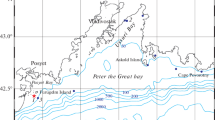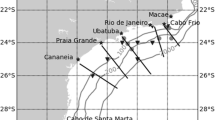Summary
An interpretation of current measurements yields, as a typical feature of the cross-component over the upper slope, two circulation cells with opposite rotation. Here coastal upwelling has been assumed to be mainly a two-dimensional phenomenon. Over the upper continental slope the core of the subsurface onshore return flow (∼+10 cm s−1) occurs at intermediate depths of 60 m to 70 m and above the bottom over the shelf. This flow causes a convergence just beneath the actual relatively shallow upwelling layer. A great part of the water masses of the return flow feeds the Ekman flux in the surface layer. Another minor part, however, sinks down the slope contributing to a weak offshore component above the bottom. It is suggested that the strength, the thickness and the depth of the onshore compensation flow increase with the intensity of upwelling.
The observations, moreover, give evidence of a ‘coastal jet’ at the surface and a poleward going undercurrent.
The amplitude of the effective fluctuations superposing the mean flow is larger over the slope than over the shelf. In the spectra the amplitude of the semi-diurnal tide is dominating. It seems to be constant within the upper 100 m independent of depth, but is increasing at greater depths. Over the shelf no significant fluctuations with periods smaller than the semi-diurnal tide have been observed. This is probably due to relatively strong mixing, dissipating the short oscillations of lower energy over the shelf.
However, in contrast to the conditions over the slope, even longer periods than the semidiurnal tide, as for example the inertial fluctuations (∼33 h), are insignificant over the shelf during the period of observations.
Zusammenfassung
Die Interpretation von Strommessungen ergibt als typisches Merkmal des mittleren vertikalen Stromaufbaus normal zum Schelf zwei Zirkulationszellen entgegengesetzter Rotation. Hierbei haben wir vorausgesetzt, daß der küstennahe Auftrieb näherungsweise ein zweidimensionaler Vorgang ist. Danach tritt der Kern des auflandigen Kompensationsstroms (∼+10 cm s−1) über dem oberen Kontinentalabhang in einer Zwischenschicht in 60–70 m Tiefe und über dem Schelf in der bodennahen Schicht auf.
Der Kompensationsstrom verursacht unterhalb der relativ flachen Auftriebsschicht eine Konvergenz. Ein Teil seiner Wassermassen steigt zur Kompensation der divergenten Oberflächenströmung auf. Ein kleinerer Teil sinkt jedoch am oberen Kontinentalabhang in tiefere Schichten und trägt zu einer schwachen ablandigen Stromkomponente über dem Boden bei. Es ist zu erwarten, daß Stärke, Mächtigkeit und Tiefenlage des Kompensationsstroms mit wachsender Intensität des Auftriebs zunehmen.
Die Meßergebnisse geben außerdem deutliche Hinweise für die Existenz eines nordwärts setzenden Unterstroms und des ‘coastal jet’ in der Oberflächenschicht.
Die der mittleren Strömung überlagerten effektiven Schwankungen sind über dem Kontinentalabhang größer als über dem Schelf. Die halbtägigen Gezeiten besitzen die größte Amplitude. Sie ist in den oberen 100 m, unabhängig von der Wassertiefe, konstant; nimmt jedoch mit größerer Tiefe zu. Über dem Schelf sind die Schwankungen, deren Periode kleiner als die der halbtägigen Gezeit sind, unbedeutend. Dies ist wahrscheinlich auf die Dissipation der kürzeren, energiearmen Schwingungen durch die relativ starken, turbulenten Vermischungen über dem Schelf zurückzuführen.
Im Gegensatz zu den Verhältnissen über dem Kontinentalabhang sind aber auch längere Schwankungen, wie zum Beispiel die Trägheitsschwingung (∼ 33 h), über dem Schelf während der Beobachtungszeit bedeutungslos.
Résumé
Une interprétation des mesures de courant met en évidence, comme un caractère typique de la composante transversale, l'existence de deux cellules circulant dans des sens opposés sur le talus continental supérieur. On y a supposé que l'upwelling côtier était surtout un phénomène à deux dimensions. Au-dessus du talus continental supérieur, le noyeau du courant sub-superficiel retournant vers la côte (∼ +10 cm s−1) se situe à une profondeur intermédiaire de 60 à 70 mètres et au-dessus du fond sur le plateau continental. Ce courant provoque une convergence, juste au-dessus de la propre couche d'upwelling qui est relativement peu épaisse. Une grande partie de la masse d'eau du courant de retour alimente le courant d'Ekman dans la couche de surface. Cependant, une autre partie, moins importante, descend vers le bas du talus et contribue à former une faible composante au large, au-dessus du fond. Il est supposé que la force, l'épaisseur et la profondeur du courant de compensation venant du large augmentent avec l'intensité d'upwelling.
En outre, les observations mettent en évidence un ‹jet› côtier à la surface et un courant inférieur allant en direction du pôle.
L'amplitude des fluctuations qui se superposent au courant moyen est plus grande sur le talus que sur le plateau continental. Dans les spectres, c'est l'amplitude de la marée semi-diurne qui domine. Elle semble être constante et indépendante, de la profondeur jusqu' à 100 mètres, mais elle augmente pour de plus grandes profondeurs. Sur le plateau continental, on n'a pas observé de fluctuations significatives, à des périodes inférieures à celle de la marée semi-diurne. Cela est probablement dû à des processus de mélange relativement importants qui atténuent les oscillations courtes de moindre énergie sur la plateau continental.
Cependant, contrairement aux conditions sur le talus continental, même les oscillations à des périodes plus longues que la marée semi-diurne, comme par exemple les fluctuations dues à l'inertie (∼ 33 heures), sont insignifiantes sur le plateau continental pendant la durée des observations.
Similar content being viewed by others
References
Allen, J. S., 1973: Upwelling and coastal jets in a continously stratified ocean. J. phys. Oceanogr.3, 245.
Geißler, H., 1941: Die deutschen Hochseepegel. Archiv dt. Seewarte61, 3.
Gill, A. E., 1971: Ocean models. Philos. Trans. R. Soc. Lond. A,270, 391.
Hurlburt, H. E., and J. D. Thompson, 1973: Coastal upwelling in a β-plane. J. phys. Oceanogr.3, 16.
Johnson, J. A., 1973: Upwelling layers in a steady, winddriven stratified ocean. J. phys. Oceanogr.3, 203.
Maigret, J., 1972: Campagne expérimentale de pêche des Sardinelles et autre espèces pélagiques. Juillet 1970–October 1971.1, 1. [Hrsg.:] Societé Centrale Pour L'Equipement du Territoire International.
Mittelstaedt, E., 1972: Der hydrographische Aufbau und die zeitliche Variabilität der Schichtung und Strömung im nordwestafrikanischen Auftriebsgebiet im Frühjahr 1968. “Meteor” Forsch.-Ergebn. (A) Nr. 11. S. 1.
Mittelstaedt, E., 1973, On the stratification and circulation in the upwelling area off NW-Africa. Coast. Upwelling Ecosyst. Anal.-Newsletter, Vol.2, No. 3.
Mittelstaedt, E., 1974; Some aspects of the circulation in the NW-African upwelling area off Cap Blanc. Téthys [in print].
Mooers, C. N. K., R. L. Smith and C. A. Collins, 1973: The dynamic structure of the frontal zone in the coastal upwelling region off Oregon. J. phys. Oceanogr. [in print]
McNider, R. T., and J. J. O'Brien, 1973: A multi-layer transient model of coastal upwelling. J. phys. Oceanogr.3, 258.
O'Brien, J. J., and H. E. Hurlburt, 1972: A numerical model of coastal upwelling. J. phys. Oceanogr.2, 14.
Weichart, G., 1974: Meereschemische Untersuchungen im nordwestafrikanischen Auftriebsgebiet. “Meteor” Forsch.-Ergebn. [in print].
Author information
Authors and Affiliations
Rights and permissions
About this article
Cite this article
Mittelstaedt, E., Koltermann, K.P. On the currents over the shelf off cap blanc in the northwest African upwelling area. Deutsche Hydrographische Zeitschrift 26, 193–215 (1973). https://doi.org/10.1007/BF02232613
Received:
Issue Date:
DOI: https://doi.org/10.1007/BF02232613




